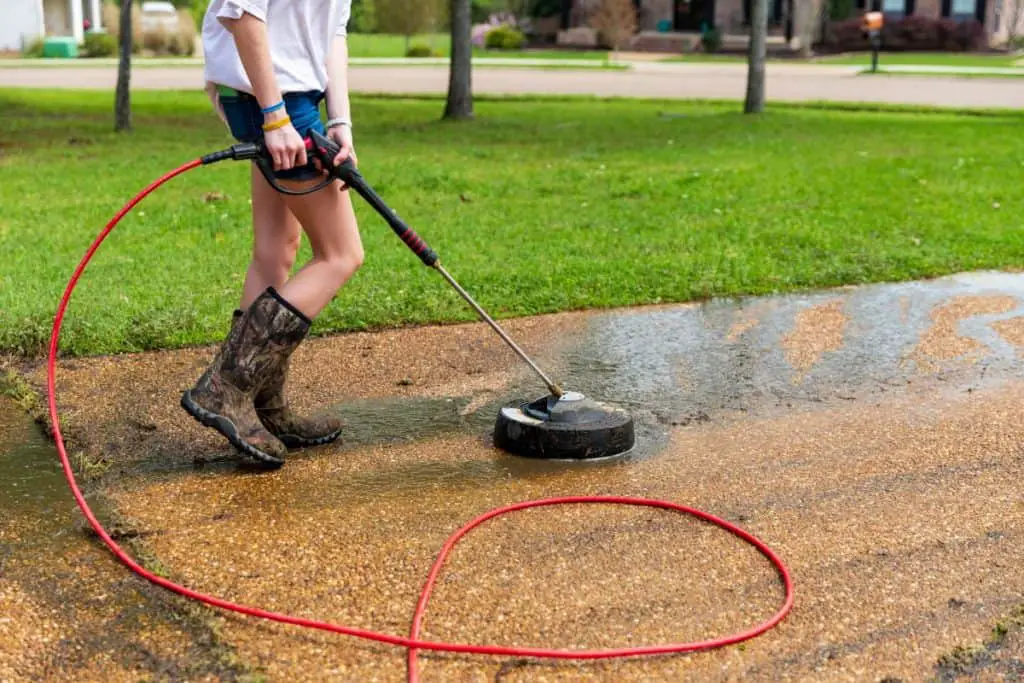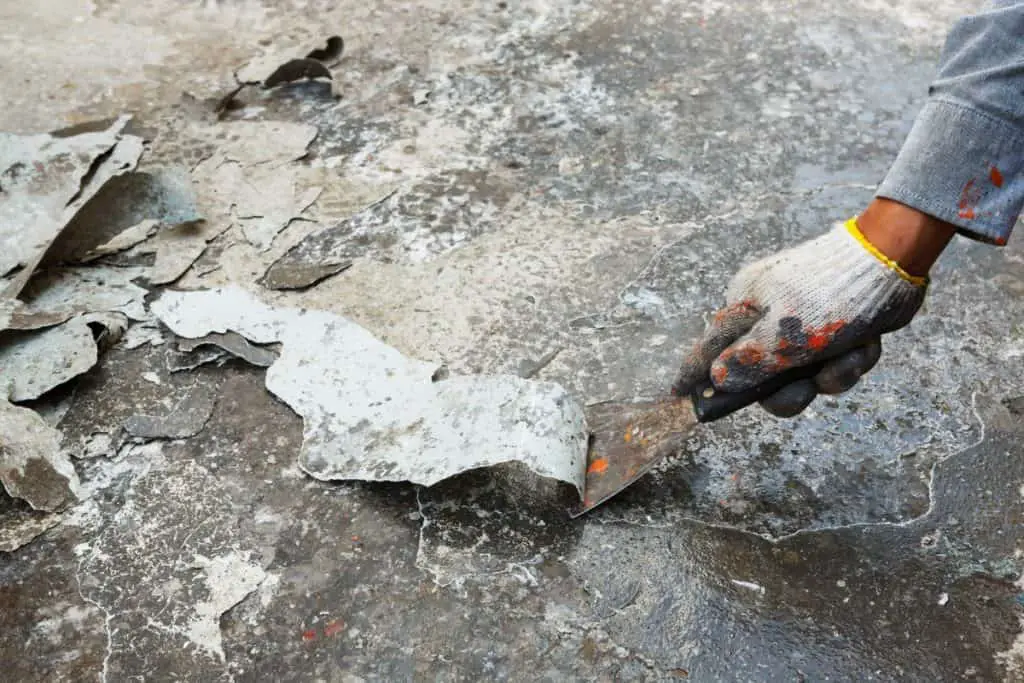Concrete is a timeless material that can be used for almost any project or space, but sometimes it’s fun to spice it up a bit. If you don’t want to go through the tedious process of resurfacing and stamping or etching a design in your concrete, staining it is always a great option. One question you may have is “can old concrete be stained?”
It is possible to acid stain old concrete. Acid stains are colored washes that soak into the surface of your concrete. This means that as long as your concrete is not sealed, finished with epoxy, or painted over, you should be able to stain it whatever color you want, no matter the age of your surface.
Hopefully, this is a satisfactory answer to your acid staining question, but this is not all we have to offer. To learn more about whether or not your concrete can be acid stained as well as 10 helpful tips on how to do it, continue reading.

Table of Contents
Can Your Concrete Be Acid Stained?
Staining is a fun and easy way to add color, pattern, and character to your concrete surface, but it cannot be done on every concrete surface.
In order to stain your concrete, it must be bare, exposed, concrete.
This is because of the nature of acid stains; acid stains are wet mixtures of pigment and chemicals that, when poured onto a concrete surface, create a unique color and pattern due to the reaction they have with the components of your concrete.
Since the acid stain must touch the actual concrete and soak into its pores, you cannot acid stain concrete that is covered in paint, that has been epoxied, or that has been sealed.
Concrete paint, epoxy, and sealants coat the concrete in a way where the pores cannot be reached, so the acid stain will not take to these surfaces, no matter how new or old your concrete is.
The good news is that -as long as your concrete is exposed- you will be able to acid stain your concrete surface!
If you are bummed out about this answer because you have painted, sealed, or put epoxy over your concrete, don’t worry! There are ways to remove these things so you can apply an acid stain to your concrete.
Removing Paint Before Acid Staining Old Concrete

To remove paint from your concrete surface, simply get an industrial strength paint remover, pour it over your surface, and wait for it to take.
Once you see the paint start to soften and lift from the surface of your concrete, take a hand scraper or power washer and remove as much paint as possible.
You can repeat this process as many times as needed to remove all traces of paint.
After the paint is removed, just clean and prep your surface, then stain it!
Removing Sealant From Concrete
A sealant is often put in place over stains to ensure they stay beautiful and don’t get ruined by other substances falling onto them.
If you have sealant over another stain, it is important to know that sealant removers often distort the color of the stains beneath them, so be careful when using these products.
Thankfully, you do not have to use a commercial sealant remover: you can also use a sander, pressure washer, or other power tool mixed with coarse materials to grind, sand, or blast the sealant away.
Removing Epoxy From Concrete
Concrete floor epoxy is the most difficult surface material to remove as it is a hardened polymer.
The three easiest ways to remove epoxy are:
- Soak it in acetone and wait till it is soft enough to scrape off of your surface.
- Use paint thinner to remove the epoxy using the same soaking method as with acetone.
- Use a heat gun to melt and scrape the epoxy off of the concrete.
As I said, none of these methods are easy, but they do work. Once your epoxy is off, it may be smart to sand and clean your surface, just to make sure every trace of epoxy is gone.
Acid Staining Old Concrete
By now, your concrete surface should be exposed and ready for staining. The only real concern to have when it comes to staining old vs new concrete is the cleanliness.
Old concrete is much more likely to have grease, wax, oil, or any other assortment of materials on its surface, so cleaning it is an essential step.
Clean your concrete by sweeping, mopping, and cleansing it with the best concrete cleaner to ensure all debris is eliminated.
If any dirt, dust, or other material is left on your concrete, it will be apparent after staining.

Finally, your old concrete surface should be completely prepared for staining.
Just like with new concrete, you should test a small section of your concrete surface to make sure it turns out to be the color you desire.
Once you are confident in your color, apply the stain, let it cure, neutralize it, and seal it, just as you would with fresh concrete.
Read our in-depth guide to concrete staining and how to apply them!
10 Helpful Tips Before Acid Staining Old Concrete
Finally, we arrive at the tip section. These 10 tips are being given to make your concrete stain look the best it can, no matter how old your concrete is.
1. Easiest Way of Removing Sealant
If you have sealant on your concrete, the chemical Xylene is one of the most effective things you can use to remove it.
You should pour Xylene on your sealant, let it sit for ~30 seconds, then scrape it off using a stiff bristle broom if indoors and blast it off using a power washer if outdoors.
2. Double Staining Old Concrete
If your concrete is old, there is a good chance it has been stained before. Sadly, the concrete stain cannot be removed, but you can stain over it.
However, this second layer of stain will not take as well as the first, will not take at all in some areas, will be discolored, and will change the original stain color.
3. Seal Your Acid Stained Concrete
When your stain has done its job, it is a good idea to seal it using a water-based sealant. Water-based sealants will not distort the color of your stain, so they are a safe route.
The sealant also preserves the color, texture, and integrity of both your concrete and stain.
4. Apply the Stain With a Sprayer for Best Results
Acid stain can be applied in many ways, but the best way is with a sprayer. Other methods such as mopping, brushing, or rolling can leave streaks, bristles, or lines in your stain, whereas spraying will leave your color even and smooth.
5. Try Different Colors Before Choosing
Once you have selected the color you want for your concrete, buy 3 that are close to it but not 100% the same. Test all colors on a small area of your concrete and buy a larger size of whichever you choose.
The reason for this spot test is that acid stain -unlike paint- reacts with the components within the concrete, meaning it will look differently on your concrete than it does online.
Related article: Selecting the Perfect Acid Stain for Your Concrete Work
6. Buy More Acid Stain Than You Think You Need
When buying acid stains for your old concrete, make sure to buy 20%-50% more than you think you need.
Old concrete is extremely absorbent due to the time it has had to dry and cure, so it will typically soak up 20%-50% more stain than new concrete.
Related article: Cost of Acid Staining a Concrete Floor: What you need to know
7. Prepare Enough Acid Stain Before You Apply It
Before you apply your stain, it is smart to get a large bucket and mix multiple bottles of your stain into it, rather than use them one by one.
The reason for this is that every bottle is slightly different and, though we cannot see it in the liquid, the results of each bottle will be just different enough to notice when looking at your concrete surface.
8. Get a Smooth Look by Having a Wet Edge
To guarantee your concrete has a smooth, even look to it, always have a wet edge when applying your stain. If you leave it to dry and come back later, you will be able to see the harsh stop/start line in your concrete.
9. Be Sure to Not Apply Too Much Acid Stain
Overapplaction means applying too much stain on your concrete and not allowing it to soak into the concretes pores.
Overapplication results in a messy, unsightly, build-up of color on your concretes surface.
To avoid this, apply your stain in coats, being sure it can handle each coat by doing a small patch test before the overall application.
10. Take Care of the Concrete to Make It Last
Once your concrete is stained and sealed, you must maintain it regularly. This may be in the form of washing, cleansing, or even resealing your concrete, but it will ensure your acid stain stays beautiful for as long as you have your concrete.



